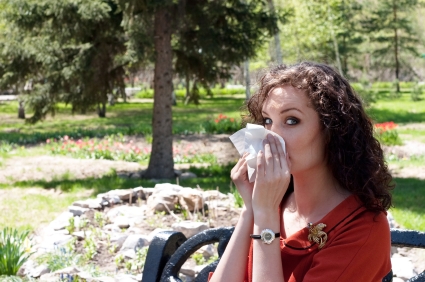Hay fever! The word alone seems terrifying, and to the ones who suffer from it, it’s an all too realistic nightmare. So what is hay fever exactly? Also known as Allergic rhinitis, hay fever is simply an allergic inflammation of the nasal airways. It doesn’t sound very threatening, and depending on its severity, hay fever can ruin a person’s life during the high pollen count times of the year. Pollens trigger an antibody called immunoglobulin E (IgE) which then binds to mast cells and basophiles containing histamine. The histamine releases are what causes the symptoms that affect up to 30% of all Americans, including up to 40% of children and 10%-30% of adults.
Generally, spring is the danger zone for anyone with high sensitivities to pollen. There are two levels to the symptoms experienced: common and severe. Common symptoms are annoying and can ruin a day. These include: sneezing, watery eyes, itchy throat and nose, and blocked/runny nose. Severe symptoms aren’t as common, but include: sweating, headaches, facial pain, loss of smell and taste, and the spread of the itchiness. These symptoms can excel into fatigue, insomnia, and irritability.
What causes hay fever entirely depends on the person’s sensitivity to certain pollen. Tree pollen tends to effect people in the spring. Grass pollen affects people in late spring and all summer, while weed pollen is most common in the autumn. Fungi and mold spores can also cause hay fever. This is more prevalent in warm weather. Also family history and asthma are big triggers for hay fever.
Knowledge is power, so educate yourself about hay fever, and what exactly causes your specific symptoms. Skin and blood tests are two tests that can reveal what exactly you are sensitive to. OTC Antihistamines sprays or tablets such as Claritin, Alavert, Zyrtec work well. If one wants to take the prescription route then Fexofenadine (Allegra) and the nasal spray azelastine (Astelin) are the best. In the department of eye drops, any eye drop that contains cromoglycate is affective. A good example of this is Opticrom. Nasal Corticosteroids are effective for long-term treatment. Fluticasone (Flonase), fluticasone (Veramyst), mometasone (Nasonex) and beclomethasone (Beconase) are all some of the best nasal sprays in the market. If the person shows severe allergy symptoms doctors may even prescribe prednisone.
The thing about hay fever is that you can’t really do anything to prevent it from ever happening. As a result, you need to limit your exposure to pollen by regularly washing your eyes with cool water, showering and washing your cloths more often. In addition, wear glasses and hats, and clean your house and pets regularly. If you’re a smoker, you now have one more reason to quit because smoking causes a great sensitivity to pollen. Utilizing these tips will make your life less of a battle zone so you can actually stop and smell the roses every once in a while.



